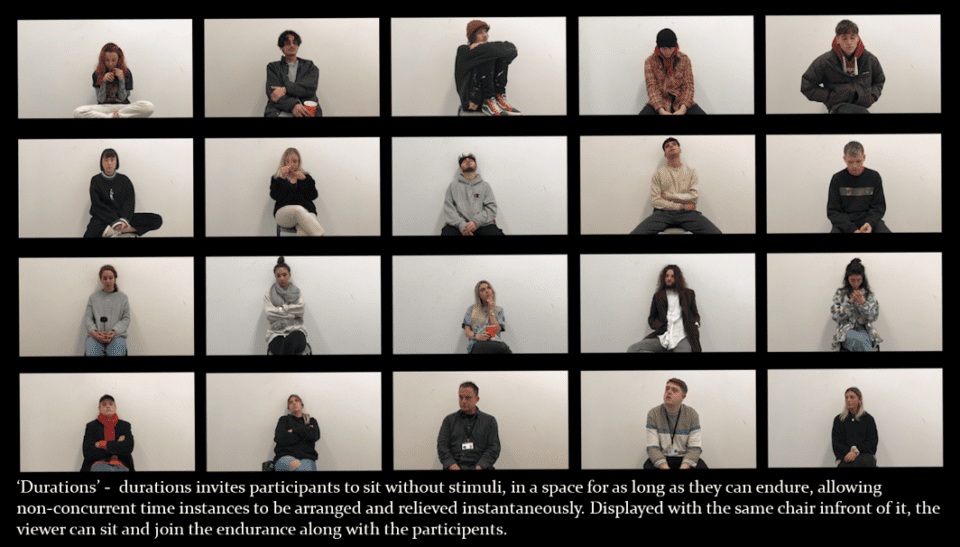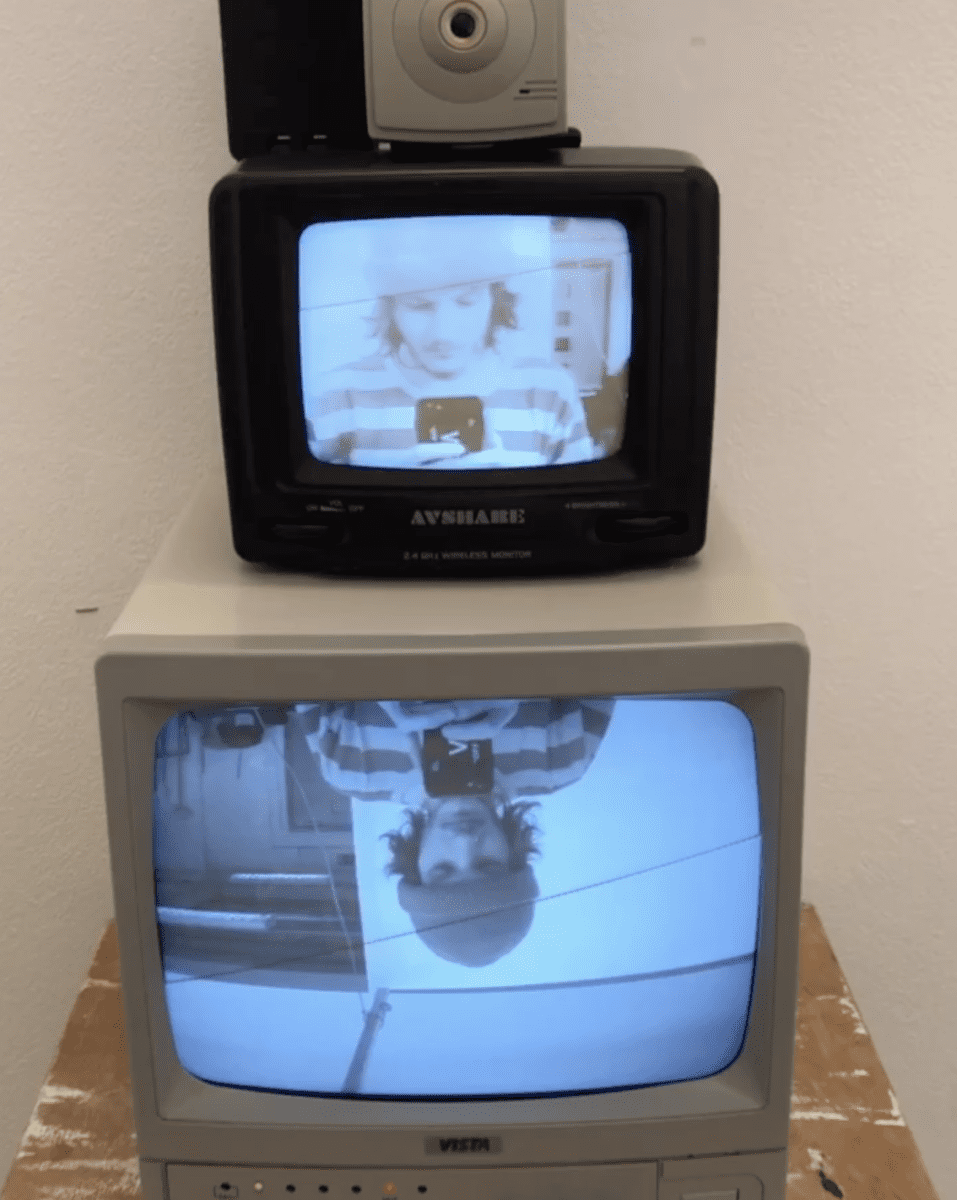In the 21st century, screens are everywhere. How often do we notice them? Archie Brooks is a graduate from Leeds Arts University questioning the relationship between technology and user. His work navigates real and virtual spaces, encouraging viewers to look more closely at themselves.
Brooks’ work is part of Leeds Arts University’s 2020 undergraduate showcase, an inspiring virtual exhibition which questions, experiments and responds to the world in radical ways. The artist speaks to Aesthetica about communication in a pandemic, and how his work encourages self reflection.
A: Let’s talk about the artwork that is part of the degree show.
AB: I presented a recording from a website I coded and created, which can be found here. The website is a method of allowing a viewer to have an intimate introspective experience. It asks a question and then cuts to black, allowing the visitor to see their own reflection in the screen. Questionme has three tiers of questions progressively becoming more intimate. Each tier is randomised, creating a unique experience every time the site is visited. The viewer is in a scenario where the more time they spend with the screen, the more in depth the self reflection becomes.
A new prevalence of technological communication has arisen under lockdown: our communications have universally become more screen-based than in any other era. Questionme is removed from the public scenario of an exhibition and experienced in your own home, which allows for more comfortable introspection. The familiar environment of your own screen is now the host for self questioning. The viewer has an intimate relationship with their domestic space: it is a safe place in which people can explore the questions truthfully.

A: What types of media do you work in?
AB: I primarily consider myself a video artist, however most of my works end up as installations as viewer interaction has become key to my practice. Art Historian Claire Bishop emphasises the importance of the audience in the development of art. She says: “installation art desire[s] to heighten viewer’s awareness of how objects are positioned (installed) in a space, and of our bodily response to this.” In my installations, these ‘objects’ are the viewer, the spectator is the catalyst of the work. Their presence allows it to perform, as key as lighting and sound in film. They are not just a viewer; they are the artwork.
Obsolete monitors are a key medium of mine, each having its own history of displaying and being watched. They have aged through their own undisclosed timeline. These observation screens now become a means of being observed. The spectator is now the feature of the work; watching the screen brings attention to themselves.
A: What are the themes explored in your piece?
AB: My practice is informed by how humans relate to the lens, and the notion of an observer. In Discipline and Punish, philosopher Michel Foucault described the prisoner of a panopticon as being at the receiving end of asymmetrical surveillance: “He is seen, but he does not see; he is an object of information, never a subject in communication.” Thus, the prisoner polices himself through fear of consequence.
Another example is Jean-Paul Sartre, whose phenomenological description of how observation creates a self-reflective condition is easily applicable to my work. “I see myself because somebody sees me,“ he says. This submits to the notion that if we believe we are being observed, we instinctively self evaluate how we are perceived.
The exploration of how we relate to screens is another large part of my practice. When we watch a screen, we watch the personalised content whilst being largely unaware of the physical screen itself, and our relation to it. There is a clear difference in design between a screen used for displaying train departures and one required for high resolution cinema, for example. However, it is the data that grabs our attention. The user directly relates to the content.

A: Where do you find inspiration?
AB: I find that there is no true way to find inspiration for pieces, you have to let it find you. This does not mean sitting back and hoping that an idea strikes you. Most of my ideas generate from previous ideas as I work through them. There were many times, as an early artist, that I would have an idea, discount it and not do it. These ideas are the best to pursue.
My current practice of exploring self evaluation comes from an attempt at creating art that is an experience, where the viewer is essential for the work to operate. I am creating spaces which encourage people to be introspective and exist – momentarily – in acts of self reflection. This presence in the moment is necessary and often hard to find. My work attempts to enforce this state of mind, visually showing new vantage points to induce self observation and raise questions.
A: What do you hope audiences take away from your piece?
AB: My work has a large amount of philosophical research that backs it, although the viewer should be unaware of this. My art is applicable to anyone – with prior art knowledge or not. Each viewer will become more aware of themselves, whether it be viewing my work in their own space or within an art space.
I hope to subvert what art can be and allow it to shift the focus from the work to the viewer. By shifting the onus of making and allowing the participant full control, the viewer becomes creator. They are responsible for how the art is experienced in this new space mediated by their own movement.
A: What are your future plans? Do you have any projects / ideas lined up?
AB: I am currently working on a commission for the artist studio Assembly House in Leeds. Before lockdown, I held an open call for an exhibition, Aspect, which I was co-curating at the venue. This was cancelled with just a week until the show. When this happened, we took Aspect online and hosted a week of talks and blogs which highlighted some of the artists’ work. The commission I am working on will be a continuation from some of these themes, but will most likely become a research-based project in which I propose some sort of phenomenological method of questioning.
A: What can viewers expect from Leeds Arts University’s online degree show?
AB: Leeds Arts University has a wide range of different artists, working in a variety of different media. The online degree show is a great platform to allow people at home to explore their practices, with links to their websites and Instagrams for further exploration.
Leeds Arts University’s Undergraduate Showcase is live now until 30 September. Find out more here.
@artchie.b
Images courtesy Archie Brooks.







